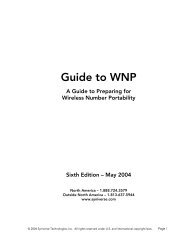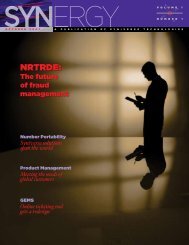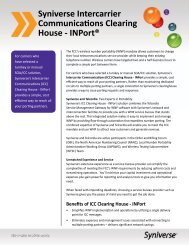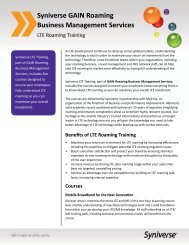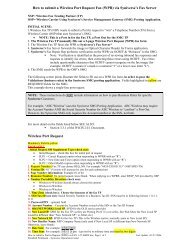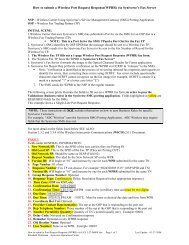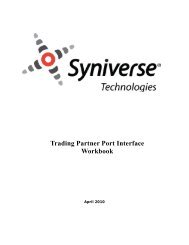Syniverse Signaling Solutions for International Roaming
Syniverse Signaling Solutions for International Roaming
Syniverse Signaling Solutions for International Roaming
You also want an ePaper? Increase the reach of your titles
YUMPU automatically turns print PDFs into web optimized ePapers that Google loves.
<strong>Syniverse</strong> <strong>Signaling</strong> <strong>Solutions</strong><br />
<strong>for</strong> <strong>International</strong> <strong>Roaming</strong><br />
The <strong>Syniverse</strong><br />
<strong>Signaling</strong> <strong>Solutions</strong><br />
<strong>for</strong> <strong>International</strong><br />
<strong>Roaming</strong> function<br />
as an ANSI-41 call<br />
processor that provides<br />
interoperability among<br />
the various revisions<br />
of the TIA/EIA ANSI-41<br />
signaling family and<br />
seamless translation of<br />
international roaming<br />
protocols.<br />
To solve switch, signaling, routing and numbering problems associated with<br />
international roaming, and to enable network elements in one country to route<br />
messages to other countries without the need <strong>for</strong> indirect routing in either the home<br />
or serving network, <strong>Syniverse</strong> <strong>Signaling</strong> <strong>Solutions</strong> provide the industry-unique,<br />
comprehensive signaling interoperability technologies today’s operators need <strong>for</strong><br />
international roaming.<br />
The <strong>Syniverse</strong> <strong>Signaling</strong> <strong>Solutions</strong> function as an ANSI-41 call processor that provides<br />
interoperability among the various revisions of the TIA/EIA ANSI-41 signaling family<br />
and seamless translation of international roaming protocols. As a service control<br />
point (SCP), the ANSI-41 call processor enables wireless operators to use one<br />
signaling point code instead of directly routing to hundreds of switches and networks<br />
around the world.<br />
Benefits of <strong>Signaling</strong> <strong>Solutions</strong><br />
• Eliminate complex international roaming setup requirements.<br />
• Enable seamless international roaming call and service delivery.<br />
• Streamline network and switching operations and testing.<br />
• Reduce serving market operations requirements.<br />
• Support international roaming <strong>for</strong> prepaid and postpaid subscribers.<br />
Features of <strong>Signaling</strong> <strong>Solutions</strong><br />
The <strong>Syniverse</strong> <strong>Signaling</strong> <strong>Solutions</strong> resolve a wide variety of interoperability difficulties,<br />
including:<br />
Management of Multiple MIN Ranges and Point Codes<br />
All MIN ranges and point codes are directed to a single point code through<br />
<strong>Syniverse</strong>’s centralized call processor, which resolves problems associated with MIN<br />
and point code overlap.<br />
System Identifier (SID) Mapping<br />
System identifier (SID) codes can present numbering conflicts between countries.<br />
Wireless systems use five-digit SID codes to uniquely identify each operator’s<br />
network and market. Operators use codes designated by their national<br />
telecommunications authority within the range specified <strong>for</strong> their country. Since<br />
international coordination of SID assignments is relatively recent, some SIDs are<br />
in use by operators in more than one country. An operator with a large base of<br />
embedded non-IFAST SIDs must either find a solution to potential SID conflict issues<br />
or consider reprogramming handsets. The <strong>Syniverse</strong> <strong>Signaling</strong> <strong>Solutions</strong> solve the<br />
SID conflict problem – when ANSI-41 signaling messages are routed through our call<br />
processor, the in-country SID is mapped to an IFAST SID.
• Eliminate complex<br />
international roaming setup<br />
requirements.<br />
• Enable seamless international<br />
roaming call and service<br />
delivery.<br />
• Streamline network and<br />
switching operations and<br />
testing.<br />
• Reduce serving market<br />
operations requirements.<br />
<strong>International</strong> TLDN – Automatic Call Delivery<br />
Due to the variety of telephone numbering schemes throughout the world, countries<br />
have adopted different dialing methods to place international calls. The <strong>for</strong>mat<br />
of international numbers varies among countries and switches. For example, a<br />
wireless subscriber in a European country might have to dial “44” be<strong>for</strong>e placing an<br />
international call; a wireless subscriber in North America may have to dial “011-44.”<br />
Within IS-41 call delivery, a home cellular switch must be able to receive international<br />
dialing strings from the serving switch and append the international outbound<br />
code <strong>for</strong> the particular home country. Some switches using ANSI-41 standards are<br />
unable to determine if a temporary location directory number (TLDN) received from<br />
a serving switch is <strong>for</strong>matted as a national or international number. This renders<br />
the switch helpless to determine how to use the received TLDN to deliver a call to a<br />
subscriber roaming internationally. <strong>Syniverse</strong>’s centralized call processor determines<br />
the necessary manipulation of the received TLDN to build a digit stream that routes<br />
the call between the specific international locations.<br />
ANSI SS7-to-ITU C7 <strong>Signaling</strong> Interoperability<br />
Often referred to as C7 and SS7, these network types require protocol conversion in<br />
order to support ANSI-41 messages that enable international roaming. <strong>Syniverse</strong>’s<br />
centralized call processor’s ANSI/ITU-T signaling interoperability provides a gateway<br />
between ANSI- and ITU-based signaling networks.<br />
TIA/EIA Protocol Interoperability<br />
<strong>Syniverse</strong> provides roaming interoperability between markets that use different<br />
revisions of the TIA/EIA protocol by providing interoperability between ANSI Rev. C<br />
markets and markets using IS-41 Rev. A and Rev. B. You can choose roaming partners<br />
based on market coverage need, allowing subscribers to experience seamless<br />
roaming regardless of the ANSI-41 revision level.<br />
Switch Type Incompatibility<br />
Despite ef<strong>for</strong>ts made by switch vendors to ensure final published versions of<br />
signaling and other standards clearly and accurately represent the requirements<br />
<strong>for</strong> network compatibility, operators still must deal with significant interoperability<br />
issues. Using the <strong>Syniverse</strong> <strong>Signaling</strong> <strong>Solutions</strong>, you work directly with <strong>Syniverse</strong><br />
rather than with multiple switch vendors to identify and resolve these issues with<br />
roaming partners.<br />
Short Message Service (SMS) Routing<br />
Subscriber demand <strong>for</strong> SMS while roaming continues to increase. Un<strong>for</strong>tunately,<br />
delivery has been limited by multiple addressing parameters, interworking issues and<br />
variations in network standards, including the use of ITU and ANSI point codes on
different networks. Using sophisticated addressing and routing technologies, the<br />
<strong>Syniverse</strong> <strong>Signaling</strong> <strong>Solutions</strong> deliver and terminate SMS messages regardless of the<br />
message destination.<br />
<strong>International</strong> SMS Rating and CIBER Creation<br />
Some roaming partners (serve) do not create CIBER records <strong>for</strong> international SMS<br />
messages (MO and MT), preventing home operators (<strong>Syniverse</strong> <strong>Signaling</strong> <strong>Solutions</strong><br />
customers) from being able to bill their subscribers a specific retail rate <strong>for</strong> these<br />
messages.<br />
<strong>International</strong> SMS Rating and CIBER Creation is an optional service in which <strong>Syniverse</strong><br />
provides its customers rated CIBER 22 call detail records <strong>for</strong> its incollect CDMA<br />
international SMS messages. <strong>Syniverse</strong> extracts data from the customer’s SMDPP<br />
messages traversing <strong>Syniverse</strong>’s Rev C call processor, rates the messages according to<br />
the customer’s specifications and creates CIBER 22 incollect records.<br />
Users of this service must also be <strong>Syniverse</strong> ACCESS® Clearing and Settlement Service<br />
customers.<br />
Welcome SMS Service <strong>for</strong> CDMA Operators<br />
This service allows you to welcome subscribers with an SMS text message(s) when<br />
they reach their roaming destination. This capability supports the FCC/CTIA mandate<br />
requiring operators to supply consumers with international roaming rates. Simply<br />
provide the message content to <strong>Syniverse</strong> and we will automatically deliver the<br />
message. You also can give subscribers general roaming instructions or clarify how to<br />
make international calls while roaming. Features include:<br />
• Recognition of whether the message needs to be generated upon registration by<br />
the subscriber.<br />
• Content tailored to the roaming location<br />
• Language flexibility – you designate the language of choice <strong>for</strong> the message<br />
(some restrictions may apply, depending on character set).<br />
• Adequate message capacity to provide subscribers with the right amount of<br />
in<strong>for</strong>mation (message size limit is 160 bytes).<br />
• Operator-defined parameters to ensure subscriber does not receive duplicate<br />
messages.<br />
WIN Routing Service<br />
Many CDMA operators offer their subscribers services based on the Wireless<br />
Intelligent Network (WIN) IS-826 standard. WIN Routing Service supports the routing<br />
and processing of WIN-based IS-826 messaging. This <strong>Signaling</strong> <strong>Solutions</strong> feature<br />
enables services such as international CDMA prepaid roaming between a home<br />
operator’s IS-826 WIN-based prepaid plat<strong>for</strong>m (SCP) and IS-826-compliant markets.
About <strong>Syniverse</strong><br />
<strong>Syniverse</strong> makes mobile work <strong>for</strong><br />
more than 900 mobile operators,<br />
cable and Internet providers,<br />
and enterprises in over 160<br />
countries. With unmatched<br />
expertise and 25 years<br />
simplifying the complexities<br />
of roaming, messaging and<br />
networking, <strong>Syniverse</strong> serves<br />
as the <strong>for</strong>ce at the center of<br />
the mobile communications<br />
universe, keeping people<br />
connected today and <strong>for</strong>ging<br />
new connections <strong>for</strong> tomorrow.<br />
Nobody knows mobile like<br />
<strong>Syniverse</strong>.<br />
The service supports both CDMA voice and SMS text messaging. WIN Routing Service<br />
also will route the messaging required <strong>for</strong> generating “tones” from a serve market<br />
switch (MSC) that can be used to notify prepaid subscribers of their low balance.<br />
<strong>Roaming</strong> Partner Control<br />
Unbillable roaming occurs when a serving operator inadvertently provides services<br />
to a roamer whose home operator does not have a roaming agreement in place<br />
with the serving operator. The resulting roaming activity cannot be billed back to the<br />
subscriber, leading to revenue loss <strong>for</strong> the serving operator. <strong>Roaming</strong> partner control<br />
helps operators prevent this type of unbillable roaming from occurring in their<br />
networks by allowing operators to automatically restrict a roamer’s call delivery, call<br />
origination and SMS messaging. The tool ensures operators only enable services <strong>for</strong><br />
paying roamers, helping stop roamers from using services <strong>for</strong> free.<br />
Operator-Level Identity <strong>for</strong> SMS<br />
Many operators see the potential value in billing their subscribers different SMS rates<br />
based on the subscriber’s roaming location. But until now, location-based billing<br />
has been both costly and resource intensive. Operator-level identity <strong>for</strong> SMS gives<br />
operators a simple, cost-effective method <strong>for</strong> location-based SMS billing that can<br />
increase messaging revenue. Instead of having to maintain a database of hundreds<br />
of roaming partners’ switches, operators can use a table of unique predetermined<br />
(virtual) MSCID values created and maintained by <strong>Syniverse</strong> to route messaging<br />
through the <strong>Signaling</strong> <strong>Solutions</strong> call processor plat<strong>for</strong>m.<br />
Additional Features<br />
SS7 Test Simplification<br />
Wireless operators need only to connect to and test with the <strong>Syniverse</strong> call processor<br />
on initial implementation.<br />
Enhanced Customer Service and Troubleshooting<br />
Customer service is provided by a knowledgeable <strong>Syniverse</strong> representative with the<br />
necessary language skills to communicate and resolve issues quickly.<br />
Enhanced Network Monitoring<br />
The <strong>Syniverse</strong> network operations center monitors network problems or signaling<br />
errors 24 hours a day, seven days a week, and communicates with operators via fax,<br />
pager or email.<br />
Visibility® Services<br />
<strong>Signaling</strong> <strong>Solutions</strong> integrates with <strong>Syniverse</strong> Visibility Services <strong>for</strong> network<br />
monitoring to enable troubleshooting and customer care.<br />
© 2012 <strong>Syniverse</strong> Technologies, LLC. All rights reserved under U.S. and international copyright laws. Rev. 09-12




